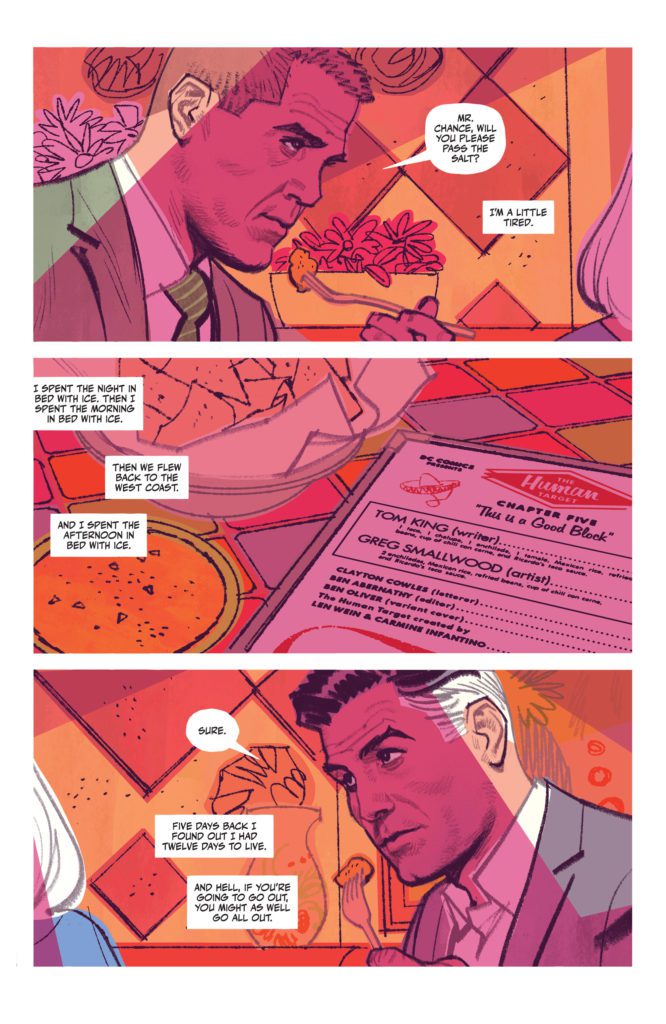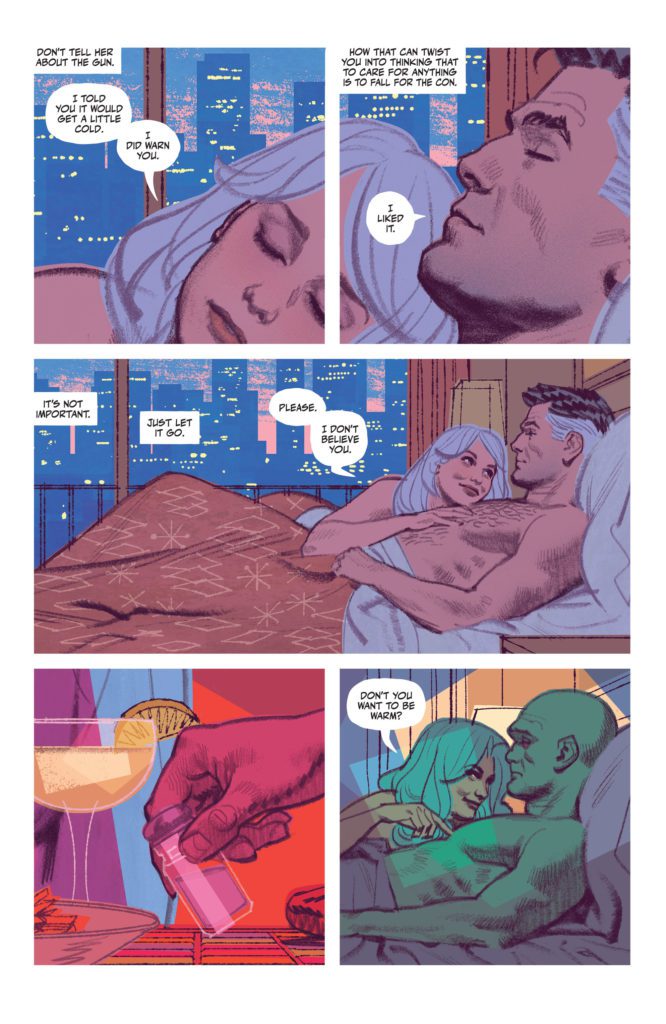I’m a bit of a stickler for subtext. If you’ve read any of my articles before – on the off chance that you’ve noticed my name in the byline – then you’ll know it’s my own personal soapbox. If you can’t fit the information naturally into the story, well, chances are the reader doesn’t need to know it. I’ve seen fantastic ideas lost in a sea of overexplaining. And I’ve seen mediocre premises turn into compelling narratives because the writer played it close to the vest. But, on very rare occasion, I’ve come across a script with mountains of exposition that just works. DC Comics’ The Human Target #5 is one such script. Writer Tom King, artist Greg Smallwood, and letterer Clayton Cowles give us a tour of Christopher Chance’s life. And somehow, they trick us into learning a metric ton about the character, while enjoying every second of it.

Writing
Maybe part of what makes King’s script work so well is that it’s a little scattered. We bounce between the thought lives of different characters, often confusing one person’s memories for someone else’s. He wants us to feel a little lost. The characters certainly do. Yet, on a second read, the intertwining threads are clear, even when they seamlessly transition back and forth. But King also sets up a frame story for this issue. He gives us a reason for Chance to be telling us so much about how he came to be the Human Target. We’re not learning what drives Chance simply because the script dictates that we do. We’re told about Chance’s history in a story where he’s learning how to keep his past hidden. This issue doesn’t feel like it’s full of flashbacks. Every line, every memory, is fully relevant to what Chance is going through right now.
MFR ON YOUTUBE (latest video)
Help us reach 5K Subs!
That, of course, is talking about King’s work on this issue in rather broad strokes. He didn’t force feed us information, he found brilliant and creative ways to subtly get his ideas across. But the specificities of each scene are also brilliant. In some of Chance’s memories, the captions feel rehearsed. He’s waxing poetic about the moments that defined him. These are the thoughts he returns to, the ones he refines on each revisit. But in Chance’s childhood memories, the captions are run-on sentences that feel like they’re all coming out in one breath. It reads just like a six-year-old who’s so thrilled to tell you about his day. King can write in the voice of a haunted hitman, a desperate father, a gentle goddess, a misunderstood alien, or an excited child. Reading it all and getting swept away with the story, it’s hard not to write with the tone of an excited child, myself.
Art
Smallwood’s art is somehow crisp, clean, and smooth, while maintaining a joyful messiness around the edges. While the forms he creates are proportionate and neat, the details of the work have little squiggled quirks to them. You can see each individual pencil line. Some look hurriedly scribbled along the side of someone’s face, others jut out slightly past the outlines that are supposed to contain them. Even Smallwood’s colors don’t fit inside the lines. The measured linework of a gun is colored in by a grey shape with moderately wobbly edges, which create a simpler outline than Smallwood’s pencils. All these “mistakes,” however, are undoubtedly deliberate. Smallwood achieves two things with this: First, he makes the art feel relaxed. You can picture Smallwood doodling all of it, only half paying attention while he downs a glass of bourbon in true Human Target style, instead of slaving over the page with a ruler and compass. (With the quality of his work, I’m pretty sure he does plenty of slaving, with a flourish here and there to make it all look effortless.) Secondly, he makes you intently aware of the form of his work. You find yourself noticing every line made by his pencil and marveling at the intricacies of his brushstrokes.
And of course, the coloring isn’t just there to make this issue look relaxed and effortless. Smallwood uses the colors to show us how Chance feels about the many memories rattling around inside his head. We start in the present day in a Mexican restaurant. The mingled pink and red of the scene is more than just mood lighting. It soon becomes a color coding for danger. As alarm bells go off in Chance’s head, we return to this scene again and again. And later, we see Chance reliving a trauma. The colors are nearly identical to his memory of lying next to someone in bed. Perhaps Smallwood is telling us that Chance’s haunted past is never far away. Even in his moments of bliss, he remembers the horrors that have defined him.

Lettering
Cowles’ edgeless word balloons add to the easygoing tone of this whole series. They’re blobs of white, mixing into the rest of the scene like they’re part of the furniture. There’s rarely much reason to notice them. They tell the story in smooth lines that trace your eye across every page. Again, it’s all effortless. But the times you do notice the lettering, it’s magic. We see a character react to someone hurting him. His reaction is “GNNNNN.” The letters are italicized and they jostle together in an uneven line. It’s his pain, even his arousal, at being touched. The next page, we see Chance make a similar noise: “NNNNN.” The “G” is missing, but everything else remains the same. He’s in pain, but it’s the kind of thing he can handle. It’s even the kind of thing that gets him going. Three panels later and Chance is screaming in full force.
The letters strain against the bonds of their word balloon, only keeping a thin layer of white intact around them. We’ve never seen anything remotely like this from Chance. We may move back to the usual cadence of the story – smooth lines and the occasional dirty secret whispered in small font – but we don’t forget that we just saw Chance reach his limit. In restraining himself for four issues, Cowles has made a moment stick out spectacularly. Normally, a lettering quirk like that would be par for the course in comics. It would happen a half a dozen times in an issue and the effect would be lost. But this is the first time we’re seeing an affect like this, and it feels huge. We feel like we’re seeing behind the many masks of Christopher Chance, all because he let out a little scream.
I’ve called The Human Target comic book magic before. Every issue makes me want to say it again. The Human Target #5 is also a rare breed in storytelling. This creative team has stuffed this issue to the brim with exposition and information about our main character. In the hands of plenty of other creators, this issue could feel heavy-handed and overdone. But The Human Target #5 teases out every new revelation with subtlety and finesse. Yes, this is a fantastic comic book issue. But it’s also a textbook example of how to communicate exposition in all the right ways. Don’t miss this stunning new issue, out from DC Comics February 22nd at a comic shop near you!

